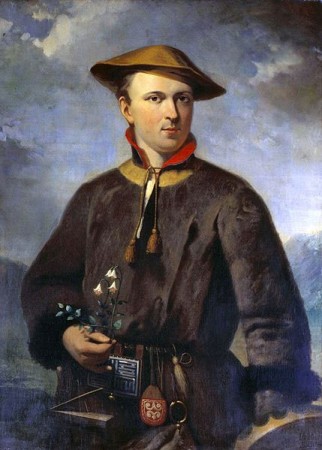Who first catalogued flora and fauna of the region? The “Apostles of Linnaeus”

Carolus Linnaeus in Laponian costume. Artist: Hendrik Hollander (1823–1884). Photo: University of Amsterdam, public domain
Carl Linnaeus is a name that needs no introduction to students of botany and natural science. Linnaeus (1707-1778) was a Swedish naturalist and explorer who is generally credited with modern definitions and classifications of, well, life!
As it happens, I am not a serious student of natural science. But I’ve been hearing about Linnaeus from childhood because one of my grandfathers was a botanist who specialized in taxonomy. In the strict religious sense, botany does have a patron saint: St. Albert the Great. But for grandfather and his ilk, that status more properly belongs to Linnaeus.
Borrowing the religious analogy further, Linnaeus didn’t accomplish that grand work alone. He had “apostles”, 17 of them. They roamed the world gathering information to further the great goal of discovering and classifying the world’s plants, animals, insects, etc. You can read about each one – and their travels – at this site from the IK Workshop Society.
A limited edition of material written by those apostles was presented by Sweedish Ambassador Teppo Tauriainen to the Canadian Museum of Nature this past July. As detailed by this press release, it’s valuable stuff:
The publication of the writings of Linnaeus pupils (apostles) consists of a series of eight volumes – in all 11 books and over 5,500 pages – which has been in preparation since the late 1990s,and now published by the non-profit IK Foundation. All the accounts of the apostles’ journeys to every continent have been published for the first time in English; those of the apostles who left no travel journals are described through their correspondence or other sources. In the introductory and concluding volumes world experts in various subject fields will provide accounts of the 18th century, of Linnaeus, of travelling and the hardships of fieldwork, together with biographies and an index covering approximately 5,500 indexed printed pages, resulting in around 150,000 specific search terms and a considerable number of cross references or references to modern biological nomenclature.
Volume three of the eight volume set includes the writings of PEHR KALM, who travelled the eastern regions of North America including the southern part of Canada from Niagara to past Quebec City with details information on the cultural and natural history.
The digital version of the volumes is almost complete six of the eight volumes are available on-line at http://www.ikfoundation.org/ibooks/ibooks.php
The Ottawa Citizen’s Tom Spears summarized Linnaeus’ advice to the travelers and recounts how “our” regions’s apostle, Pehr Kalm, filled journals with pithy and instructive observations on the people – as well as the flora and fauna of the region. Kalm explored New France and adjacent U.S. colonies from 1748-1751.
Here’s Kalm’s take on Montreal:
“One of the first questions they propose to a stranger is whether he is married,” Kalm wrote.
The second question was whether Canadian girls are prettier than the ones he left at home. “And the third, whether he will take one home with him?”
As well, the single women of Montreal were always jealous that ships from France landed first in Quebec, and the girls there scooped up husbands fresh off the boat.
When he wasn’t taking notes on Canadian women, Kalm was hard at work examining the natural environment of what is now Quebec and New York.
According to Spears, the 11 volume gift is at the museum’s library in Aylmer. As mentioned above, most (though not all) of the material is also available online.
Tags: Ambassador Teppo Tauriainen, canada, Canadian Museum of Nature, Carl Linnaeus, natural science, Pehr Kalm






.jpg)

Thanks for an interesting post! Peter Kalm was pretty frank in his cultural observations. I found a translation of his writings at Paul Smith’s College. Here are some notes on what he made of the Adirondacks: http://www.adirondacklifemag.com/blogs/2013/02/13/peter-kalms-1748-adirondack-journey/
Great stuff Mary, thanks much for that link!